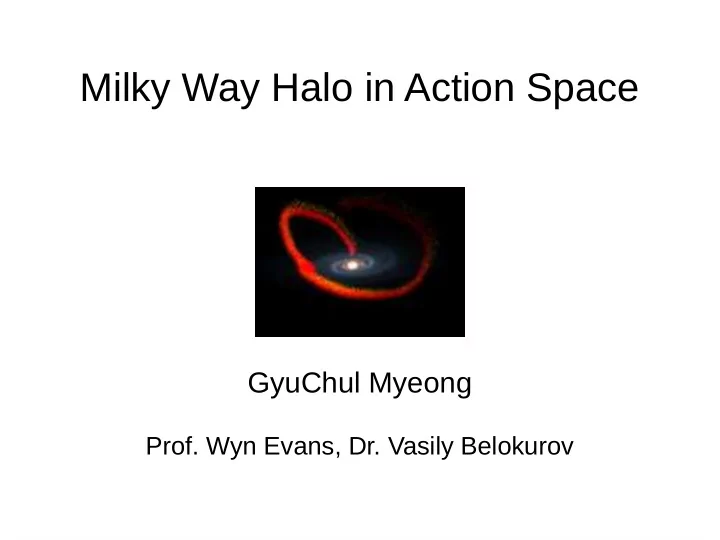

Milky Way Halo in Action Space GyuChul Myeong Prof. Wyn Evans, Dr. Vasily Belokurov
Milky Way Halo in Action ● Halo structure as a “collection of orbits” – Overall structure as a sum of individual stellar orbit – Actions provide a useful map of the local halo ● Various components: – Chemo-dynamical dichotomy (see also, Deason et al. 2011; Belokurov et al. 2018; Haywood et al. 2018; Helmi et al. 2018) – High energy, retrograde, and metal-rich component – Resonant component 2
Slicing with metallicity E (x10 5 km 2 /s 2 ) E (x10 5 km 2 /s 2 ) -1.5 < [Fe/H] < -1.3 -2.1 < [Fe/H] < -1.9 E (x10 5 km 2 /s 2 ) E (x10 5 km 2 /s 2 ) -1.7 < [Fe/H] < -1.5 -2.3 < [Fe/H] < -2.1 E (x10 5 km 2 /s 2 ) E (x10 5 km 2 /s 2 ) -2.9 < [Fe/H] < -2.3 -1.9 < [Fe/H] < -1.7 J Φ (km/s kpc) J R (km/s kpc) J Φ (km/s kpc) J R (km/s kpc) 3
The Rich ● Metal-rich ( -1.7 < [Fe/H] < -1.3 ) – more distended toward high J R , narrower in J z → flattened, radial anisotropy – radially anisotropic velocity dispersion → (σ R , σ Φ , σ z ) = (155, 77, 88) km/s → axis ratio, q ~ 0.6 – 0.7 – originated from the radial infall of a massive satellite? (see also, Belokurov et al. 2018; Myeong et al. 2018; Haywood et al. 2018; Helmi et al. 2018) 4
The Poor ● Metal-poor ( -2.9 < [Fe/H] < -1.7 ) – similar in all three actions → rounder isotropic morphology – excess at positive J Φ → net prograde rotation ~ 49 km/s – close to isotropic velocity dispersion → (σ R , σ Φ , σ z ) = (125, 114, 110) km/s → axis ratio, q ~ 0.9 – reminiscent of the (kinematic) distribution of halo globular clusters → disintegrated stellar material? – accretion of low-mass dwarf satellites? 5
The Retrograde stars E (x10 5 km 2 /s 2 ) E (x10 5 km 2 /s 2 ) -1.5 < [Fe/H] < -1.3 -2.1 < [Fe/H] < -1.9 E (x10 5 km 2 /s 2 ) E (x10 5 km 2 /s 2 ) -1.7 < [Fe/H] < -1.5 -2.3 < [Fe/H] < -2.1 E (x10 5 km 2 /s 2 ) E (x10 5 km 2 /s 2 ) -2.9 < [Fe/H] < -2.3 -1.9 < [Fe/H] < -1.7 J Φ (km/s kpc) J R (km/s kpc) J Φ (km/s kpc) J R (km/s kpc) 6
The Retrograde stars ● Metal-rich (e.g., [Fe/H] > -1.9) ● High energy (e.g., ) E > − 1.1 × 10 5 km 2 s − 2 ● Retrograde (J Φ < 0), large radial action, J R → eccentric, retrograde population ● Clear tail-like feature along the energy range → tracing the orbital decay process of the progenitor ● Potential evidence of a retrograde merger/accretion event in the past → potential link with ω Centauri? 7
The Resonant stars E (x10 5 km 2 /s 2 ) E (x10 5 km 2 /s 2 ) -1.5 < [Fe/H] < -1.3 -2.1 < [Fe/H] < -1.9 E (x10 5 km 2 /s 2 ) E (x10 5 km 2 /s 2 ) -1.7 < [Fe/H] < -1.5 -2.3 < [Fe/H] < -2.1 E (x10 5 km 2 /s 2 ) E (x10 5 km 2 /s 2 ) -2.9 < [Fe/H] < -2.3 -1.9 < [Fe/H] < -1.7 J Φ (km/s kpc) J R (km/s kpc) J Φ (km/s kpc) J R (km/s kpc) 8
The Resonant stars ● Net outward motion, ~ 12 km/s, prograde rotation, ~ 140 km/s ⟨ v R ⟩ ⟨ v ϕ ⟩ ● Dynamical origin – An overdensity present at all metallicity ● around (J Φ , J R ) ~ (1100, 150) km/s kpc, E ∼− 1.6 × 10 5 km 2 s − 2 and – low-latitude stars between |z| ≤ 3.5 kpc – inner to near Solar radius → Outer Lindblad Resonance of the bar? ● Association with the Hercules stream? – has not been seen from low metallicity population (i.e. halo) before <v R > (km/s) J Φ (km/s kpc) z (kpc) R (kpc) [Fe/H] 9
References In order of date reported: – Deason et al. 2011, MNRAS, 416, 2903 – Deason et al. 2013, ApJ, 763, 113 – Myeong et al. 2018a, ApJL, 856, 26 – Belokurov et al. 2018, MNRAS, 478, 611 – Myeong et al. 2018b, MNRAS, 478, 5449 – Haywood et al. 2018, arXiv:1805.02617 – Helmi et al. 2018, arXiv:1806.06038 Also check: – https://phys.org/news/2018-07-gaia-sausage-major-collision-milky.html and the references therein 10
Recommend
More recommend